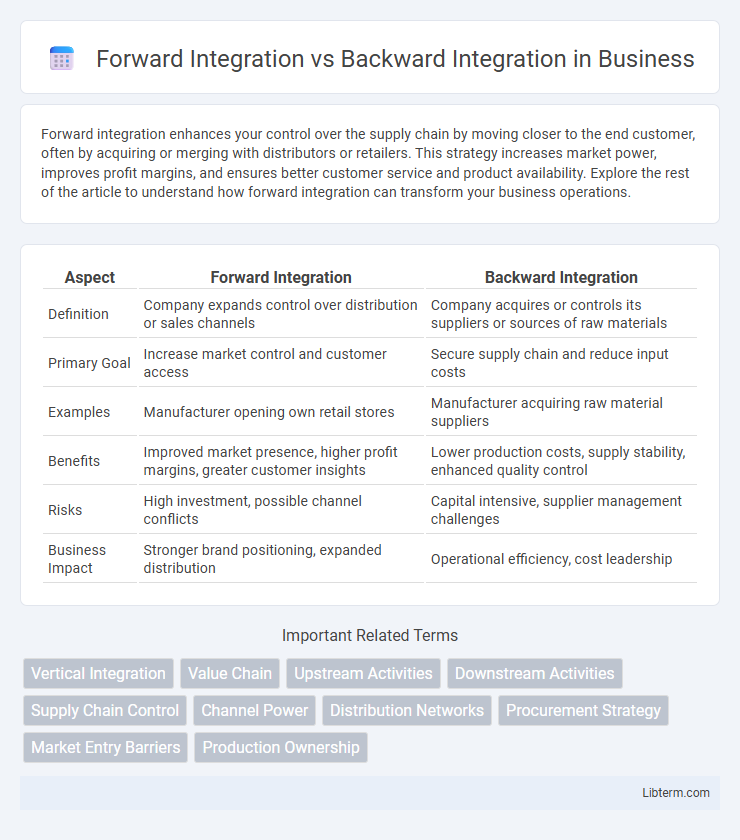Forward integration enhances your control over the supply chain by moving closer to the end customer, often by acquiring or merging with distributors or retailers. This strategy increases market power, improves profit margins, and ensures better customer service and product availability. Explore the rest of the article to understand how forward integration can transform your business operations.
Table of Comparison
| Aspect | Forward Integration | Backward Integration |
|---|---|---|
| Definition | Company expands control over distribution or sales channels | Company acquires or controls its suppliers or sources of raw materials |
| Primary Goal | Increase market control and customer access | Secure supply chain and reduce input costs |
| Examples | Manufacturer opening own retail stores | Manufacturer acquiring raw material suppliers |
| Benefits | Improved market presence, higher profit margins, greater customer insights | Lower production costs, supply stability, enhanced quality control |
| Risks | High investment, possible channel conflicts | Capital intensive, supplier management challenges |
| Business Impact | Stronger brand positioning, expanded distribution | Operational efficiency, cost leadership |
Understanding Forward Integration
Forward integration involves a company expanding its control over distribution channels or retail outlets to directly reach customers, enhancing market presence and profit margins. This strategy reduces dependence on intermediaries, improves customer experience, and accelerates feedback loops for better demand forecasting. Companies practicing forward integration often achieve stronger brand control and higher operational efficiency by managing post-production stages.
Defining Backward Integration
Backward integration involves a company expanding its control over its supply chain by acquiring or merging with upstream suppliers to reduce dependency and lower costs. This strategy enhances production efficiency, ensures raw material availability, and strengthens supply chain stability. Forward integration, by contrast, focuses on gaining control over distribution channels or retail outlets to increase market power and customer access.
Key Differences Between Forward and Backward Integration
Forward integration involves a company expanding its control over distribution channels or retail outlets to reach end consumers directly, enhancing market access and customer relationships. Backward integration focuses on acquiring or merging with suppliers to secure raw materials, reduce input costs, and improve production efficiency. The key difference lies in the direction of control within the supply chain: forward integration targets downstream activities, while backward integration targets upstream processes.
Strategic Objectives of Forward Integration
Forward integration aims to enhance market control by acquiring or merging with distributors or retailers, enabling direct access to customers and reducing dependency on intermediaries. This strategy increases profit margins through better control over pricing and brand presentation, while improving customer insights and responsiveness to market demands. Companies pursuing forward integration strengthen competitive positioning by streamlining the supply chain and fostering closer customer relationships.
Strategic Objectives of Backward Integration
Backward integration aims to enhance supply chain control by acquiring or merging with suppliers, reducing dependency on external sources and mitigating risks of supply disruptions. This strategy improves cost efficiency through direct access to raw materials, enabling better negotiation leverage and reducing procurement expenses. It also fosters enhanced quality control and innovation by integrating upstream processes, ensuring consistent input standards aligned with the company's product requirements.
Advantages of Forward Integration
Forward integration enhances a company's control over distribution channels, enabling direct access to customers and improved market responsiveness. This strategy increases profit margins by eliminating intermediaries and allows for better brand visibility and customer relationship management. Companies adopting forward integration benefit from streamlined supply chains and stronger competitive positioning in the marketplace.
Advantages of Backward Integration
Backward integration enhances supply chain control by allowing companies to directly manage production inputs, leading to reduced costs and improved quality assurance. It strengthens supplier relationships, minimizes dependency on external vendors, and ensures a stable supply of critical materials. This strategic approach also enables better inventory management and can create significant competitive advantages by increasing barriers to entry for competitors.
Risks and Challenges of Both Integration Strategies
Forward integration risks include increased operational complexity, higher capital investment, and potential channel conflicts with existing distributors. Backward integration challenges involve substantial upfront costs, dependency on raw material market stability, and risks of inefficient production if the acquired supplier lacks capabilities. Both strategies can lead to reduced flexibility and potential regulatory scrutiny due to increased market control.
Industry Examples of Forward and Backward Integration
Forward integration is exemplified by Tesla's move into direct vehicle sales and service centers, bypassing traditional dealerships to control the customer experience. Backward integration can be seen in Apple's acquisition of chip manufacturers and component suppliers to secure supply chains and reduce dependency on third parties. The oil industry demonstrates both strategies: ExxonMobil's forward integration into gas station retailing and backward integration through investments in oil exploration and refining operations.
Choosing the Right Integration Strategy for Your Business
Choosing the right integration strategy depends on your company's goals, market position, and supply chain control needs. Forward integration enhances distribution and customer interaction by acquiring or merging with distributors or retailers, boosting market access and brand loyalty. Backward integration secures supply chains and reduces production costs by acquiring suppliers or manufacturers, improving control over inventory and raw materials.
Forward Integration Infographic

 libterm.com
libterm.com